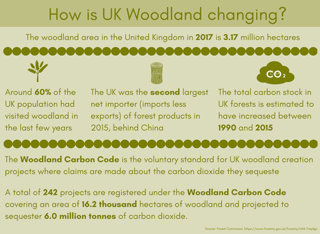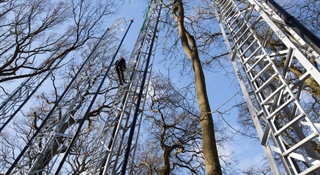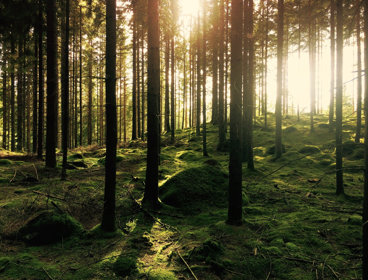October 2017
Why are forests important to the global carbon cycle?
Forests both take up, and release, carbon dioxide into the atmosphere. It is part of their role in the local and global carbon cycle. As trees grow, they store carbon in their leaves, twigs and trunk, and in the soil that surrounds them. As trees absorb carbon dioxide, they produce sugars for tree growth and release oxygen back into the air. As atmospheric CO2 increases, it is unknown how long mature forests will continue to soak up additional carbon. As it continues to increase, therefore, the capability of forests becomes indeterminate.
During the 20th century, deforestation rates rose and placed enormous pressure on forests. For example, the UK has the lowest woodland cover of any large European country, and what remains is under increasing threat from climatic changes, as well as tree diseases. As the demand for sustainable forest stewardship grows, national level of skills in forest management is declining.
Woodland Carbon Code (Forestry Commission 2017)
UK forests and climate change: summary and statistics (Forestry Commission) 2017
Forestry facts and figures (Forestry Commission) 2017

What is the Birmingham Institute of Forest Research (BIFoR)?
Trees and forests are critical components of global carbon and water cycles – they influence the thermal balance of the planet both directly, and indirectly. The natural world and its ecosystems are critical to global wellbeing and economic prosperity. BIFoR is a centre that specialises in the research of forested landscapes, anywhere in the world as part of their commitment to ‘one planet living’.
BIFoR will provide ground-breaking research into developing understanding of how our forests will respond to future increases in atmospheric carbon dioxide (CO2). As such, they have prepared a world-leading Free Atmosphere Carbon Enrichment (FACE) facility.
What is Free Atmosphere Carbon Enrichment (FACE)?
The dynamic response of forests to environmental change, including climate change, is only partially understood. In order to increase understanding, BIFoR have built a Free-Air Carbon Dioxide Enrichment (FACE) experiment in mature, unmanaged, temperate and historic woodland in Stafford. It will be monitored and studied by researchers from the University of Birmingham with the aim to predict more accurately, potentially decades in advance, the effects of rising CO2 levels on woodlands. This will be pressured until at least 2026.
How is the facility designed?

The woodland-FACE facility comprises a series of approximately cylindrical ring structures, as high as the tree canopy (around 25 meters) and 30 meters wide. Supporting pipes deliver CO2 in such a way that the woodland inside the ring experiences elevated CO2, whilst the rest of the woodland remains largely unaffected. As researchers study the site, they hope to address four key questions:
-
Does elevated CO2 increase the carbon storage within a mature woodland ecosystem?
-
Do other macro-, or micro-, nutrients (for example, nitrogen and phosphorus) limit the uptake of carbon in this ecosystem?
-
What aspects of biodiversity and ecosystem structure-and-function alter when the ecosystem is exposed to elevated CO2?
-
How can lessons from the global network of second-generation Forest FACE experiments be generalised to other woodlands and forests?
Watch the facility being constructed
Explore the site as a 3D model
Where are the other FACE facilities?
BIFoR will connect to long-term ecosystem research networks in the UK, Europe, and North America. FACE facilities exist in Australia and the Amazon in Brazil.
Follow @BIFoRUoB on Twitter for the latest updates at developments at the facility
Lesson Plans
As a starter activity, ask the class to vote agree, or disagree, with the statement “a lot more trees should be planted in the UK”. Follow this, with the statement “different types of trees should be planted to suit future climates”. Compare your answers with those released by the Forestry Commission .In, in 2017, 84% of the UK public agreed that “a lot more trees should be planted” with 76% agreeing that “different types of trees should be planted that will be more suited to future climates”.
Where are forests distributed? Take a look at this map depicting forest and woodland cover in the UK and ask students to locate areas with highest coverage and those with lowest. Are they surprised, or is this as expected?
Take a look at the downloads: Dendrochronology Exercise and Mini Free Air Carbon Enrichment Experiment (if resources permit) and have students conduct one of the experiments attached.
Take a look at the UK forests and climate change: summary and statistics (Forestry Commission). What is the data suggesting? How are forests changing?
Educational visits to the facility are encouraged; for more information about visiting the site contact them
Key Words
Carbon cycle
The circulation of carbon in the atmosphere; carbon dioxide is converted and returned to the atmosphere as a result of processes such as respiration, decay, fossil fuel combustion etc.
Carbon sequestration
Carbon sequestration is the process involved in carbon capture and the long-term storage of atmospheric carbon dioxide.
Dendrochronology
The study of trees, to address the year they were formed and analyse the atmospheric conditions of a particular period.
News
Using forests to manage carbon: a heated debate (The Conversation) 2017
Sci-fi forest tracks carbon impact (BBC) 2017
Forest is being pumped full of carbon dioxide to mimic future global warming (Huffington Post) 2017
Links
Phenocam at BIFoR (surface remote sensing of canopy phenology)



